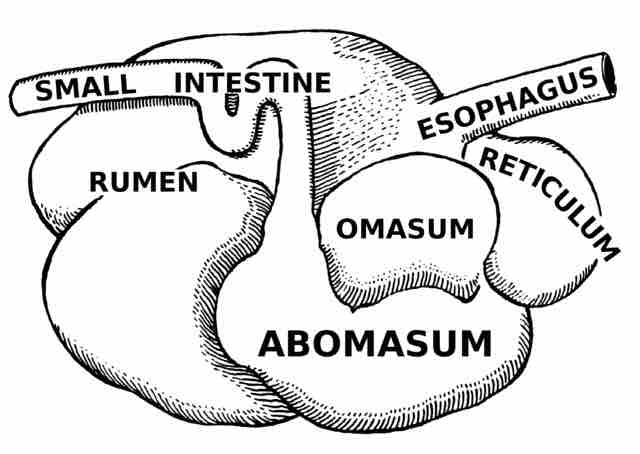A Ruminant's Multi-chambered Stomach
Ruminants are mammals that digest plant based food by processing it in a series of chambers in their stomachs. There are about 150 species of ruminants, including both domestic and wild species. Ruminating mammals include cattle, goats, sheep, giraffes, bison, moose, elk, yaks, water buffalo, deer, camels, alpacas, llamas, and antelope.
Ruminants differ from non-ruminants (called monogastrics) because they have a four-chambered stomach. The four compartments are called the rumen, the reticulum, the omasum, and the abomasum. The rumen and the reticulum are connected and work in concert and are therefore sometimes called the "reticulorumen" .

The digestive tract of a ruminant
The ruminant digestive tract has four compartments, the rumen, the reticulum, the omasum, and abomasum.
The Ruminant Digestive Process
- Ruminants chew plant matter to mix it with saliva and swallow. The food then enters the first two stomach chambers, the reticulum and rumen (or reticulorumen).
- The reticulum and rumen work together to separate solids and liquids. Contractions push solid food particles back up into the rumen, while liquids are drained into the reticulum. Specialized microbe species live in the rumen and help ruminants break down cellulose.
- Solids are formed into a bolus, called "cud," in the rumen and the solid cud is regurgitated back up to the mouth where it is chewed a second time, and returned to the reticulorumen to repeat the process.
- Liquid digesta in the reticulum is passed into the omasum where nutrients and water are absorbed into the blood stream.
- After this, digesta is passed into the abomasum, which is similar to the stomach of other animals. After the abomasum, digesta moves through the large and small intestines.
Ruminants are of interest to microbiologists because they have unique species of bacteria, yeasts, protozoa, and fungi in their rumens. The plant matter consumed by ruminants is high in cellulose, but vertebrates cannot produce cellulase which is the enzyme required to break down cellulose. Thus ruminants depend on the symbiotic microbes in their guts to break down cellulose for digestion. There is no oxygen in the rumen, so bacteria in the rumen are typically anaerobes or facultative anaerobes.